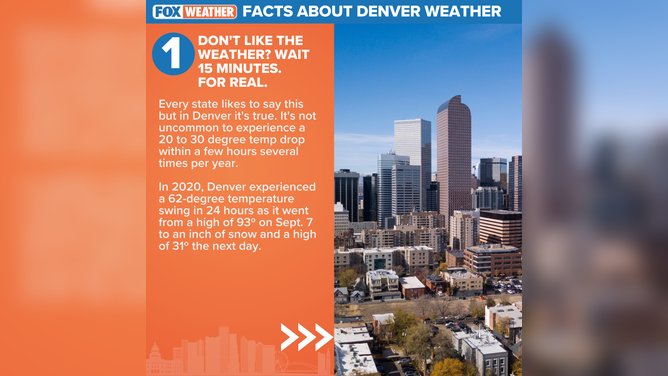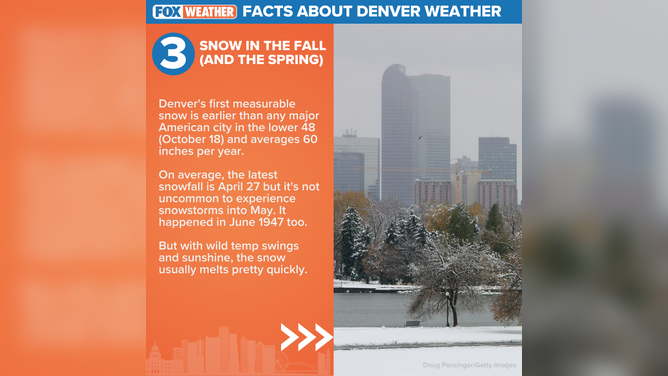7 facts about Denver weather
1. Don't like the weather? Wait 15 minutes. For real.
Every state likes to say this but in Denver it's true. It's not uncommon to experience a 20-to-30-degree temp drop within a few hours several times per year.
In 2020, Denver experienced a 62-degree temperature swing in 24 hours as it went from a high of 93º on Sept. 7 to an inch of snow and a high of 31º the next day.
2. It gets hot (and also really cold)
Denver experiences all four seasons ranging from the triple digits in the summer to single-digit temperatures in the winter.
The hottest temperature ever recorded was 105º, which the city has hit multiple times with the latest coming in June 2018.
On the other end, Denver's coldest temperature on record is -29º which was set in January 1875.
That's a 134º temperature shift!
3. Snow in the fall (And the spring)
Denver's first measurable snow is earlier than any major American city in the lower 48 (October 18) and averages 60 inches per year.
On average, the latest snowfall is April 27, but it's not uncommon to experience snowstorms into May. It happened in June 1947 too.
But with wild temp swings and sunshine, the snow usually melts pretty quickly.
4. You can get sunburned faster
Because Denver is a mile higher than sea level, the city is exposed to approximately 26% more UV radiation than at sea level, according to the University of Denver.
As you climb elevation, the air becomes less dense and thinner. The thinner the atmosphere, the more sunshine, or UV rays, are allowed to pass through.
UV exposure risk increases about 4% for every 1,000 feet of elevation gain.
5. Severe storms? Hail yes.
In May and June, the ingredients can come together to produce massive storms that produce large hail (even tornadoes).
Although the tornadoes mostly stay to the east of Denver, wind and hail are often the biggest threats of the spring storms.
Denver is considered to be in the heart of "hail alley" and Colorado makes up the second-highest amount of hail claims in the country, according to the NICB. Denver's most costly hail storm happened in May 2017 causing an estimated $2.3 billion in damage.
6. Controversy over record-keeping
Denver's official weather station has moved three times since 1882 and since 1995 has been at Denver International Airport (about 20 miles northeast of downtown).
Some Denverites would argue official weather observations should be done in the Central Park neighborhood (the former official site).
The differences come in extremes in precipitation and temperatures as the airport can often be warmer or snowier than downtown because of its location.
7. 300 days of sunshine? Not quite but close.
The Mile High City likes to say they have 300 days of sunshine each year, but that's a myth.
But Denver is still one of the sunniest cities in America with an average of 245 sunny days per year (above the 205 days average).
And we can't forget the random sunny and 70-degree days in the middle of winter -- Denver has had 12 of them since 2014.







